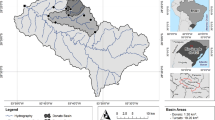Summary
Lake Van is one of the largest terminal lakes in the world. In recent years, significant lake level fluctuations have occurred and can be related to global climatic change. This fluctuation sometimes exhibits abrupt shifts. Floods originating from the lake can cause considerable damage and loss in agriculture and urban areas. Therefore, water level forecasting plays a significant role in planning and design. This study is aimed at predicting future lake levels from past rainfall amounts and water level records. A dynamical change of the lake level is evaluated by the fuzzy approach. The fuzzy inference system has the ability to use fuzzy membership functions that include the uncertainties of the concerned event. This method is applied for Lake Van, in east Turkey. Furthermore, model capabilities are compared with ARMAX model. It is shown that lower absolute errors are obtained with the Takagi-Sugeno fuzzy approach than with the ARMAX model.
Similar content being viewed by others
References
A Altunkaynak (2007) ArticleTitleForecasting surface water level fluctuations of Lake Van by artificial neural networks Water Resources Management 21 IssueID2 399–408 Occurrence Handle10.1007/s11269-006-9022-6
A Altunkaynak M Özger Z Şen (2003) ArticleTitleTriple diagram model of level fluctuations in Lake Van, Turkey Hydrol Earth Sys Sci 7 IssueID2 235–244 Occurrence Handle10.5194/hess-7-235-2003
A Altunkaynak M Özger M Çakmakcı (2005a) ArticleTitleWater consumption prediction of Istanbul city by using fuzzy logic approach Water Resources Management 19 641–654 Occurrence Handle10.1007/s11269-005-7371-1
A Altunkaynak M Özger M Çakmakcı (2005b) ArticleTitleFuzzy logic modeling of the dissolved oxygen fluctuations in Golden Horn Ecol Model 189 436–446 Occurrence Handle10.1016/j.ecolmodel.2005.03.007
GFP Box GM Jenkins (1976) Time series analysis forecasting and control Holden Day San Francisco 560
Degens ET, Kurtman F (1978) The geology of Lake Van. The Mineral Research and Exploration Institute of Turkey, Rep 169, 158 pp
Frederick KD, Gleick PH (2001) Potentional impacts on US Water Resours. In: Claussen E (ed) Climate Change Science Strategres and solutions. Virginal: Pew Center on Global Climate Chage Arlington
P Hubert JD Carbomnel A Chaouche (1989) ArticleTitleSegmentation des series hydrometeoraloques: application a des series de precipitation et de debits de L’Afrique de L’ouest J Hydrol 110 349–367 Occurrence Handle10.1016/0022-1694(89)90197-2
KN Iruine AK Eberthardt (1992) ArticleTitleMultiplicative seasonal ARIMA models for lake Erie and Lake Ontario water levels Water Reso Bull 28 IssueID3 385–396
M Kadıoğlu Z Sen F Batur (1997) ArticleTitleThe greatest soda-water lake in the world and how it is influenced by climatic change Ann Geophysicae 15 1489–1497 Occurrence Handle10.1007/s00585-997-1489-9
Kempe S, Khoo F, Gürleyik V (1978) Hydrography of lake Van and its drainage area. In: Degen ET, Kurtman F (eds) Geology of Lake Van. The Mineral Research and Exploration Institute of Turkey, Rep 169: 30–45
Kite V (1990) Time series analysis of Lake Erie levels. In: Hurtmann HC, Donalhue MJ (eds) Proc Great Lakes Water Level Forecasting and Statistics Symposium. Ann Arbor, Michigan: Great Lake Commission, pp 265–277
Loucks FD (1989) Modeling the Great Lakes hydrologic-hydraulic system. Ph D Thesis, University of Wisconsin, Madison
Mamdani EH (1974) Application of fuzzy algorithms for simple dynamic plant. Proc IEE 121: pp 1585–1588
Mathier L, Fagherazzi L, Rasson JC, Bobee B (1992) Great Lakes net basin supply simulation by a stochastic approach. INRS-Eau Rapp Scientifique 362, INRS-Fau, Sainte-Foy, 95 pp
Pappis CP, Mamdani EH (1977) A fuzzy controller for a traffic junction. IEEE Trans Syst Man Cybern, pp 7, 10, pp 707–717
Privalsky V (1990) Statistical analysis and predictability of Lake Erie water level variations. In: Hurtmann HC, Donalhue MJ (eds) Proc Great Lakes Water Level Forecasting and Statistics Symposium. Ann Arbor, Michigan: Great Lake Commission, pp 255–264
TJ Ross (1995) Fuzzy logic with engineering applications McGraw-Hill USA 600
Z Şen (1998) ArticleTitleFuzzy algorithm for estimation of solar irradiation from sunshine duration Solar Energy 63 IssueID1 39–49 Occurrence Handle10.1016/S0038-092X(98)00043-7
Z Şen M Kadıoğlu E Batur (1999) ArticleTitleCluster regression model and level fluctuation features of Van Lake, Turkey Ann Geophysicae 17 273–279
Z Şen M Kadıoğlu E Batur (2000) ArticleTitleStochastic modeling of the Van Lake monthly fluctuations in Turkey Theor Appl Climatol 65 99–110 Occurrence Handle10.1007/s007040050007
Z Şen A Altunkaynak (2004) ArticleTitleFuzzy awakening in rainfall-runoff modeling Nord Hydrol 35 IssueID1 31–43
Slivitzky M, Mathier L (1993) Climatic changes during the 20th century on the Laurentian Great Lakes and their impacts on hydrologic regime. Deauaille, France: NATO Adv Study Inst
R Sneyers (1992) ArticleTitleOn the use of statistical analysis for the objective determination of climate change Meteorol Z 1 247–256
T Takagi M Sugeno (1985) ArticleTitleFuzzy identification of systems and its application to modeling and control IEEE Trans Syst Man Cybern 15 116–132
S Vannitseni G Demaree (1991) ArticleTitleDetection et modelisation des secheresses an Sahel-proposition d’une nouvelle methodologie Hydra Continent 6 IssueID2 155–171
L Xiong AY Shamseldin MK O’Connor (2001) ArticleTitleA non-linear combination of the forecasts of rainfall-runoff models by the first order Takagi-Sugeno fuzzy system J Hydrol 245 196–217 Occurrence Handle10.1016/S0022-1694(01)00349-3
LA Zadeh (1968) ArticleTitleFuzzy algorithms Inform Control 12 94–102 Occurrence Handle10.1016/S0019-9958(68)90211-8
Author information
Authors and Affiliations
Rights and permissions
About this article
Cite this article
Altunkaynak, A., Şen, Z. Fuzzy logic model of lake water level fluctuations in Lake Van, Turkey. Theor. Appl. Climatol. 90, 227–233 (2007). https://doi.org/10.1007/s00704-006-0267-z
Received:
Revised:
Accepted:
Published:
Issue Date:
DOI: https://doi.org/10.1007/s00704-006-0267-z




